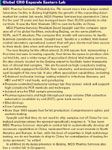Central Labs on the Move
Regional centralized labs are emerging to support global clinical trials.
These days, executives in charge of operations at large central labs spend little time in the home office. A call to their cell phones is likely to reach them in Buenos Aires, Mumbai, Singapore or Shanghai en route to the next negotiation or local operations meeting. As clinical trials are conducted on an increasingly global scale, central labs have followed suit and developed the capacity to support trials in emerging regions.

MDS Pharma Services opened its larger central lab facility in Beijing last October to accommodate sponsor demands for conducting trials in China.
Driving this expansion are the needs to lower costs and to speed up patient enrollment. Clinical trials account for nearly half the total R&D cost, and pipelines are full with late-stage drug candidates. Yet less than 20% of trials recruit on time. Clinical study sites in the traditional regions such as the United States, Western Europe, Canada, and Australia show declining accrual rates and increasing competition for eligible subjects. Even Brazil, Mexico, and Argentina are experiencing some saturation of trial activity at qualified sites.
Emerging regions such as Eastern Europe, Asia-Pacific, and Latin America offer distinct advantages with their large pools of treatment-naïve patients, faster and less competitive enrollment, and lower costs per patient. Moreover, infectious disease, certain cancers, diabetes, and other diseases show a distinct geographic prevalence outside traditional "tier 1" countries. Consequently, large Phase III studies frequently contract 40% of clinical sites in emerging regions. Despite these advantages, emerging regions present regulatory, clinical, and logistical challenges.
For instance, China and Latin American countries have prolonged regulatory approval processes that can take up to 12 months. [Recently, however, China has simplified its regulatory process; but only time will tell if changes result in faster approvals.] Differences in standard of care may prevail across a region or the availability of treatment may vary. A further limitation is variable access to comparator drugs and a prevalence of advanced rather than early disease states. In planning global studies, pharmaceutical sponsors and CROs are struggling to perform accurate feasibility assessments, develop robust assumptions for budgeting, and develop country-specific operations expertise to guide study planning and execution.
Shipping issues
A growing trend among pharmaceutical companies is to outsource aspects of clinical trial operations. Outsourcing presents a viable avenue to manage capacity constraints and access content expertise in the short term while controlling costs. Not surprisingly, the contract research services market is growing at twice the rate of the pharma industry, prompting central labs to reconsider where to invest to sustain this growth rate.

Global CRO Expands Eastern Lab
While the presence of CROs in emerging regions has grown steadily over the past years, central labs have relied on the shipment of clinical samples to established central testing laboratories in the United States and EU. Where necessitated by sample stability and time to result, central labs have formed alliances and partnerships with local laboratories to provide analytical services proximal to clinical sites. South Africa and Australia are examples of these initial efforts to globalize the central lab. The sponsor experience with such affiliate lab networks has been mixed, and often additional resources are required to maintain data quality and regulatory compliance.
However, in several regions of the world including Latin America, central labs still prefer to ship samples to their closest laboratory facility in the United States or Europe for analysis. The gains that central labs realize by this practice in operational control and quality of analysis need to be balanced against an escalation in transportation costs for sponsors. In some global trials, shipping costs can equal or exceed the budget for analysis. One reason for this is the growing proportion of sites located in secondary cities with respect to transportation. The costs associated with shipping samples from secondary cities are often a multiple of the rates that apply to primary cities.
Beyond the need to better control shipping costs, there are compelling reasons to build regional testing capabilities. A leading concern cited by central labs is turn around time for sample analysis. The short analyte stabilities for hematologic specimens and the need for rapid result reporting to determine eligibility and guide dosing decisions require flawless planning and logistics by laboratories and a good understanding of export regulations by investigators. Specialized shipping containers may be required to safeguard samples from temperature extremes. Some countries such as China have legal barriers to the export of genetic material or a preference for testing in domestic institutions.
Asian strategy emerges
While the cost of establishing wholly owned regional laboratories in emerging regions is considerable, the continued growth in clinical trial activity in Latin America, Asia, and Eastern Europe has allowed central labs to pursue a new strategy. Several central labs have diminished their operational footprints in Australia in favor of setting up testing facilities in China, Singapore, and India. These Asian facilities utilize the same analytical platforms, SOPs, and IT infrastructure as their U.S. and European operations and allow real-time global reporting of results. Such operational harmonization and control will permit the seamless integration of clinical study data sets generated in different parts of the world and represent a significant step toward the effective globalization of central labs.
How quickly will a broad range of analytical services be available in emerging regions? The answer may depend, at least initially, on tactical considerations. Indeed, central lab facilities in Asia are built to initially perform only routine testing and may add biomarker testing based on sample volume and availability of the assay on standardized automated platforms.
However, specialized testing may be a good example of how the increasing global presence of central labs can facilitate clinical research in a cost conscious environment. Oncology studies illustrate the point. As site selection and enrollment for cancer trials in the United States continue to be highly competitive and cooperative oncology groups reduce their enrollment in response to cuts in federal funding, emerging regions are becoming more attractive for subject recruitment. But sample transport from these regions can be costly and challenging. In addition, cancer protocols increasingly utilize biomarkers to determine eligibility and to explore response.
The limited availability of specialized testing in Latin America and Asia often prompts the sponsor to ship the samples to the United States for centralized analysis. Yet even in the United States or Europe, analysis of oncogenes, cellular proliferation markers, flow cytometry for cellular phenotyping or gene expression analysis are not commonly offered by central labs. While PSA is a marker commoditized for automated analysis, histological assessment of EGFR expression is not. Moreover, oncology trials routinely require pathology review that may entail multiple histological staining protocols and complex logistical arrangements for the transit of tissue blocks and slides that are difficult to execute in emerging regions.
Despite these obstacles, the benefits of providing such analytical capabilities in closer proximity to clinical sites are considerable. Central labs may again be tempted to realize these capabilities by subcontracting with local laboratories. However, the same caveats apply that beset the initial effort of central labs to globalize using affiliate networks of laboratories. Some countries like Japan have large, modern testing facilities that operate under quality standards that meet or exceed those of U.S. laboratories. In other parts of the world, such standards are not the norm and regulatory requirements for laboratory accreditation vary considerably. This means that analytical platforms, assay methodologies, validation protocols, and reagent sources have to be carefully documented and harmonized before clinical sample analysis can proceed and result data can be combined. Such diligence in harmonization is particularly important for tests that are not routine clinical tests but require considerable effort on the part of the sponsor. It may be more attractive to have the analysis be performed by a central lab's regional facility where the necessary data quality standards can be met realistically.
From a sponsor's perspective, the move by central labs to set up shop in Singapore, China, and India is encouraging and shows the industry's commitment to maintain and enhance service levels in emerging regions. Now, can we have a lab in Latin America please?
Andreas Bakker , PhD, is director, technical services global development operations, at Amgen, One Amgen Center Drive, Thousand Oaks, CA 91320-1799, email: abakker@amgen.com
Improving Relationships and Diversifying the Site Selection Process
April 17th 2025In this episode of the Applied Clinical Trials Podcast, Liz Beatty, co-founder and chief strategy officer, Inato, discusses a number of topics around site engagement including community-based sites, the role of technology in improving site/sponsor relationships, how increased operational costs are impacting the industry, and more.
Behind the Buzz: Why Clinical Research Leaders Flock to SCOPE Summit
February 7th 2025In this episode, we meet with Micah Lieberman, Executive Conference Director for SCOPE Summit (Summit for Clinical Ops Executives) at Cambridge Innovation Institute. We will dive deep into the critical role of collaboration within the clinical research ecosystem. How do we bring together diverse stakeholders—sponsors, CROs, clinical trial tech innovators, suppliers, patients, sites, advocacy organizations, investors, and non-profits—to share best practices in trial design, program planning, innovation, and clinical operations? We’ll explore why it’s vital for thought leaders to step beyond their own organizations and learn from others, exchanging ideas that drive advancements in clinical research. Additionally, we’ll discuss the pivotal role of scientific conferences like SCOPE Summit in fostering these essential connections and collaborations, helping shape the future of clinical trials. Join us as we uncover how collective wisdom and cross-industry partnerships are transforming the landscape of clinical research.
